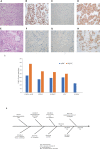Case Report: Response to ALK-TKIs in a metastatic lung cancer patient with morphological heterogeneity and consistent molecular features
- PMID: 37637057
- PMCID: PMC10450948
- DOI: 10.3389/fonc.2023.1209799
Case Report: Response to ALK-TKIs in a metastatic lung cancer patient with morphological heterogeneity and consistent molecular features
Abstract
Lung adenosquamous carcinoma (ASC) is a rare heterogeneous tumor containing two distinct components of adenocarcinoma (ADC) and squamous cell carcinoma (SQCC). The limited biopsy sampling of the primary tumor might have overlooked either the ADC component or the SQCC component, resulting in a misdiagnosis of pure histology. Genotyping for driver mutations is now routinely performed in clinical settings to identify actionable oncogenic mutations and gene arrangements. Additionally, somatic mutations can potentially serve as a marker of clonal relationships. We report a rare case of ASC lung cancer, in which metastases were identified as ADC, while the primary was initially diagnosed as SQCC based on a fibrobronchoscope brush biopsy. The primary and metastatic tumors shared ALK rearrangement and other mutations support they were derived from a single clone origin. Our hypothesis is that the primary tumor contained a minor component of ADC that was not present in the histologic sections of lung biopsy. After sequential ALK-tyrosine kinase inhibitor (TKI) targeted therapy, both the patient's primary lung tumor and the site of metastatic subcutaneous nodules decreased in size, with the metastatic sites demonstrating more noticeable shrinkage. However, after 11 months of targeted therapy, the patient was found to be resistant to ALK-TKIs. Subsequently, the patient's respiratory status deteriorated rapidly, and a cycle of immunotherapy and chemotherapy did not show efficacy. To the best of our knowledge, this is a very rare case of lung ASC, disseminated metastasizing, with distinct morphology between the primary and metastases. Different therapeutic effects of ALK-TKIs were observed in two different morphological sites, with the metastatic cutaneous lesions shrinking more significantly than the primary lung lesions, though they both harbor the same EML4-ALK rearrangement. This case may provide diagnostic and therapeutic insights into lung ASC.
Keywords: ALK rearrangement; adenosquamous carcinoma; histomorphology; metastasis lung cancer; targeted therapy.
Copyright © 2023 Yang, Liu, Liu, Zheng, Wu, Zhou, Zheng and Chai.
Conflict of interest statement
The authors declare that the research was conducted in the absence of any commercial or financial relationships that could be construed as a potential conflict of interest.
Figures


References
Publication types
LinkOut - more resources
Full Text Sources
Miscellaneous

